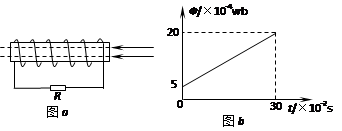问题
计算题
如图a所示,有一个N=1000匝的线圈放在磁场中,线圈电阻不计,线圈连接的电阻阻值是R=10Ω,线圈平面垂直于磁感线方向。穿过线圈的磁通量Ф随时间变化的规律如图b所示,求:
(1)线圈中的感应电动势;
(2)电阻的热功率.
答案
(1)5V;(2)2.5W
解:(1)由法拉第电磁感应定律E=ΔФ/Δt=5V;(4分)
(2)P=E2/R=2.5W;(2分)
本题考查法拉第电场感应定律,根据公式E=ΔФ/Δt可得线圈的感应电动势,跟据公式P=E2/R可得出电阻的热功率,
